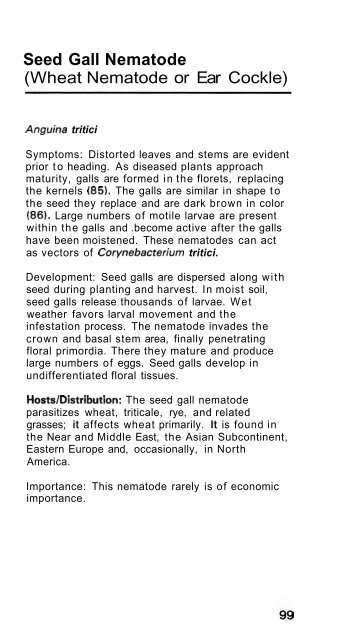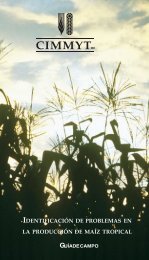Wheat Diseases and Pests - Wheat Doctor - CIMMYT
Wheat Diseases and Pests - Wheat Doctor - CIMMYT
Wheat Diseases and Pests - Wheat Doctor - CIMMYT
You also want an ePaper? Increase the reach of your titles
YUMPU automatically turns print PDFs into web optimized ePapers that Google loves.
Seed Gall Nematode<br />
(<strong>Wheat</strong> Nematode or Ear Cockle)<br />
Anguina tritici<br />
Symptoms: Distorted leaves <strong>and</strong> stems are evident<br />
prior to heading. As diseased plants approach<br />
maturity, galls are formed in the florets, replacing<br />
the kernels (85). The galls are similar in shape to<br />
the seed they replace <strong>and</strong> are dark brown in color<br />
(86). Large numbers of motile larvae are present<br />
within the galls <strong>and</strong> .become active after the galls<br />
have been moistened. These nematodes can act<br />
as vectors of Corynebacteriurn tritici.<br />
Development: Seed galls are dispersed along with<br />
seed during planting <strong>and</strong> harvest. In moist soil,<br />
seed galls release thous<strong>and</strong>s of larvae. Wet<br />
weather favors larval movement <strong>and</strong> the<br />
infestation process. The nematode invades the<br />
crown <strong>and</strong> basal stem area, finally penetrating<br />
floral primordia. There they mature <strong>and</strong> produce<br />
large numbers of eggs. Seed galls develop in<br />
undifferentiated floral tissues.<br />
HostslDistribution: The seed gall nematode<br />
parasitizes wheat, triticale, rye, <strong>and</strong> related<br />
grasses; it affects wheat primarily. It is found in<br />
the Near <strong>and</strong> Middle East, the Asian Subcontinent,<br />
Eastern Europe <strong>and</strong>, occasionally, in North<br />
America.<br />
Importance: This nematode rarely is of economic<br />
importance.



